..
| First County Visit: | Saturday 22nd September 1990 |
| Competition: | Barclays League Division 4 – (Tier 4) |
| Result: | Cardiff City 3 – 3 Stockport County |
| Attendance: | 3,374 |
| Away Trip: | 49 |
| Away Day: | 194 |
| County Line-up | 1 Paul Cooper; 2 Malcolm Brown; 3 Tony Barras; 4 David Frain; 5 Andy Thorpe; 6 Alan Finley (12 Keith Alexander); 7 Mark Payne; 8 Neil Matthews; 9 Paul A Williams; 10 Chris Beaumont; 11 Lee Todd |
| Scorers: | Neil Matthews; Chris Beaumont; Paul A Williams |
| Manager: | Danny Bergara |
| County Visits: | 2 |
..
FOR YOUR OWN SAFETY..
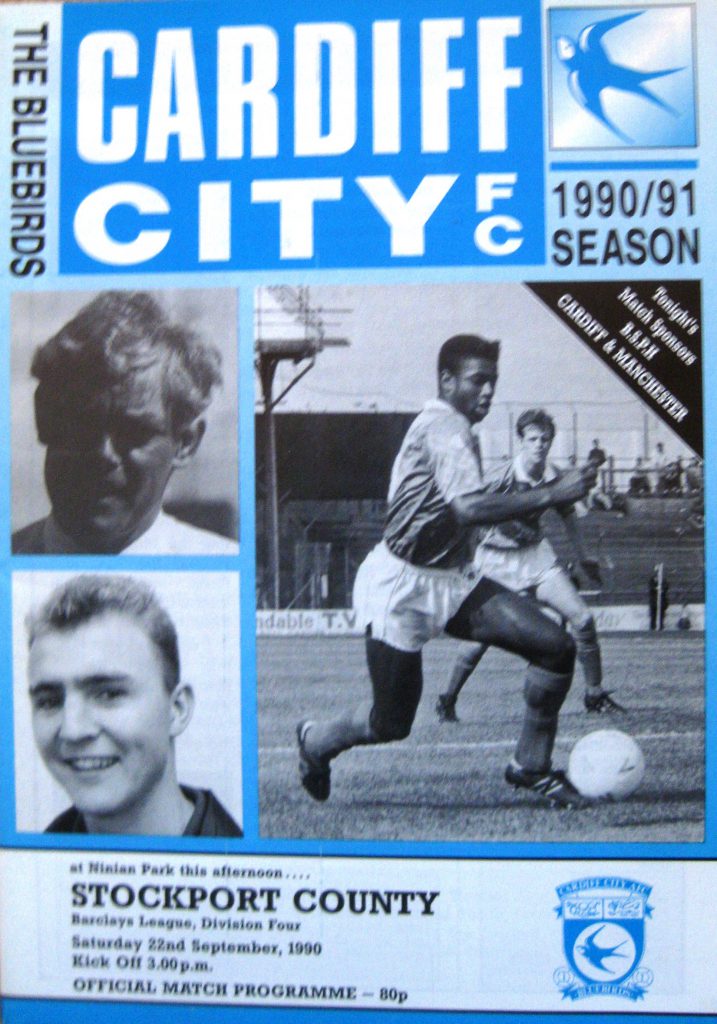
At the time of this first visit to Ninian Park I was 36 years old, and despite having seen many parts of the United Kingdom, South Wales was pretty much unknown territory.
..
There’d been plenty of family holidays in my younger days in the Northern part of the Principality, largely to Penmaenmawr a small town just outside Conwy. Note the Welsh spelling!! On all my trips into North Wales over the years I’ve marvelled at the Welsh Language, and wondered how places could be easily recognisable, for example Wrecsam, and how others where the received English name could be so different. Just passing Chester in the way to the Racecourse is a turn off to Yr Wyddgrug. Without the name ‘Mold’ in brackets there would be little clue!! And some of the trips to Wrexham have needed the tender care and attention of “Heddlu”!!!
I fondly remembered Penmaenmawr as a large expanse of beach and of course the sea. Perishing cold of course, but at the age of 8,9 or 10 it was a challenge rather than something to be shunned. Lying between the town and the ‘sands’ was the main railway line out to Holyhead and the ferries out to Ireland. It was the ‘iron horse’ which provided me with hours of entertainment whilst my parents entertained my younger siblings.
Back in the 1960’s there were still steam engines, and even though my interest in trains disappeared long, long ago when I see the grainy footage of these marvels of engineering I still feel a tinge of regret that they disappeared. The advent of trains heading to and from the Menai Bridge crossing into Anglesey was signalled by the plume of smoke in the distance. This occasioned a dash into the beach hut which had been rented for the week to grab the precious book of engine numbers. Published by Ian Allan, (a company which I note is still in the business), these were no more and no less than a schedule of engine ID markings, but which provided the prime holiday activity of noting the engines which passed, and avidly searching the book, and hoping that it was a new one that I hadn’t seen before. If so it was great excitement, and even more so if it was a ‘namer’ – a locomotive which had been honoured with a name and not merely a number.
Even from a distance of 50+ years I can still vividly recall the enjoyment I got out of what is a simple pursuit. Happy days indeed.
So, many years later came football trips. Wales had already been visited on Away Trip 32 to the Racecourse Ground. But that was a mere 50 miles from home. Cardiff was 4 times as far, and uncharted territory for me. In the pre-satnav, and indeed pre-internet, days it occasioned careful perusal of the atlas. The obvious route was down the M6 and M5 and then joining the M4 into Cardiff, but an alternative presented itself. Taking the M50 off the M5, it then wended its way done through the borders, through Monmouth, and onwards to Cardiff. With Arthur Brotherton on board, this latter option was the selected one, and proved to be just the job. It’s a more than decent trip, pretty scenic, and provides some relief from constant motorways. It’s the one I’ve always used subsequently, on a later trip to Ninian Park thence to the Vetch Field and also to the two recent homes of Newport County, the Athletics Stadium and Rodney Parade.
Arriving at the ground a large stand towered over the road, but it looked tired and well-worn from the outside. A car park stood opposite, where the car, a Volkswagen Jetta by now, (and subsequently rejoicing in the epithet of “The Shed”, courtesy of Jeff Lawrenson), was stationed. It provided car parking spaces not only for football traffic but also for the Athletics Stadium, no more than a couple of hundred yards or so from Ninian Park. Following the demise of the Bluebirds original home in 2009, after 99 years, it wasn’t a big move. The new ground, the Cardiff City Stadium, was built on the site of the Athletics arena.
..
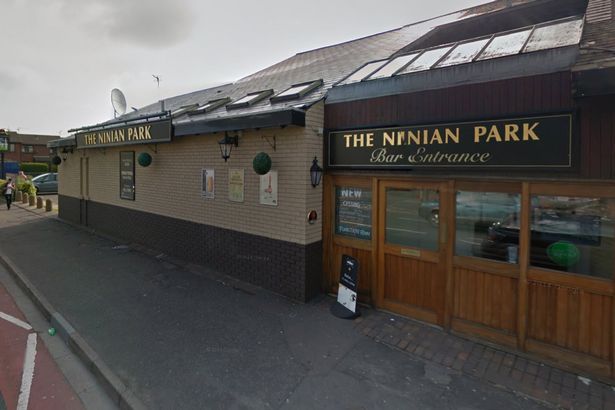
The Ninian Park … a warm Welsh welcome … NOT!!
..
Having over-estimated the journey time, it was a couple of hours before kick-off and Arthur, never shy of trying a “light bottle” or two suggested that we went in search of some refreshment. With no local knowledge and faced with a 50:50 option we turned left and not so far away espied a watering hole which, hardly surprisingly, bore the name “The Ninian Park”. And there we encountered Welsh hospitality, but sadly not of the liquid kind. An unprepossessing character stood at the entrance, and, eyeing up the two of us as we approached, moved into the middle of the doorway. There followed a one-way exchange. “I know you’re from Stockport, it’s written all over you”. Which was a little strange as we sported neither replica shirts; nor scarves, nor indeed any evidence to support this bloke’s gift of second sight. He continued, “And you’re not coming in here. Not because you’re here to cause trouble. By the look of things, you’re not up to that. It’s purely for your own safety”. I’m tempted here to say that he concluded with “Boyo”, but that would “economical with the actualite”, as Sir Robert Armstrong, Cabinet Secretary, commented at the Spycatcher trial a few years earlier. That was us told and, with refreshment reconsidered, we had to make do with a burger or some other wholesome article once inside the ground.
..
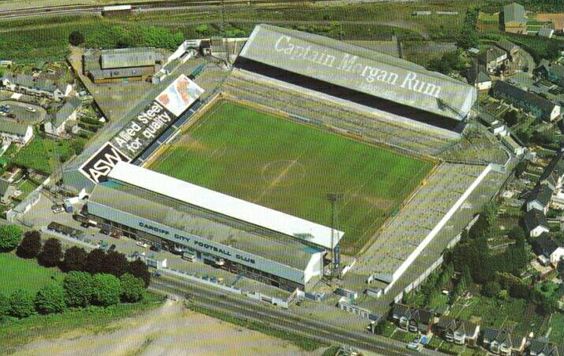
Ninian Park – aerial view as it was on the first visit
Grange End (right); Bob Bank (top); Canton Stand (left) and the Main Stand at the bottom
..
We were allocated the right-hand side of the Main Stand as we faced the pitch. The impression gained outside of a tired place was reinforced. It was an archetypal stand with the unusual addition of a flat roof added onto the original sloping cover. To the right stood the Grange End, unused and at that point unloved. Once covered, this had been removed, and an area which previously housed the vociferous home element, in what has been described as “dark and low” surroundings, now lay derelict. It took me 12 years to return, by which time the Grange End had been reinvigorated. It had been re-covered, and split into two. One part for home supporters and the other for visitors, who had been relocated from the Main Stand. It was a more than unusual configuration for travellers, with maybe 8 rows of seats at the front, behind which was terracing. I can only think of the Moss Rose, Macclesfield with a similar arrangement. One thing is for certain, that having paid for a seat, at premium price, Jeff and I were less than impressed with both the leg-room and view, and decamped to the terraced area at the rear, very early into the game.
..
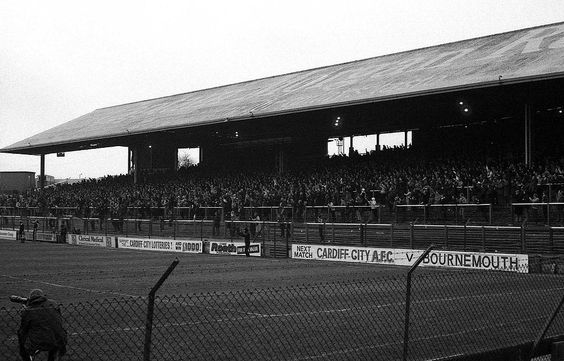
The Bob Bank .. an impressive covered terrace, albeit hardly tested in September 1990, when a paltry 3,374 turned up. Those who didn’t bother missed a cracker!
..
Opposite the Main Stand was the Bob Bank, a huge terrace, half covered, and akin to, although a little smaller than the Kippax Street at Maine Road. It must have been an impressive sight in the days when Cardiff played at a higher level and drew sizeably larger crowds than the 3,374 dotted around Ninian Park that day. To the left stood the Canton Stand which appeared from my vantage point to be a pretty dark and gloomy place. It was seated, but I wouldn’t have fancied the view from the first two tiers.
..
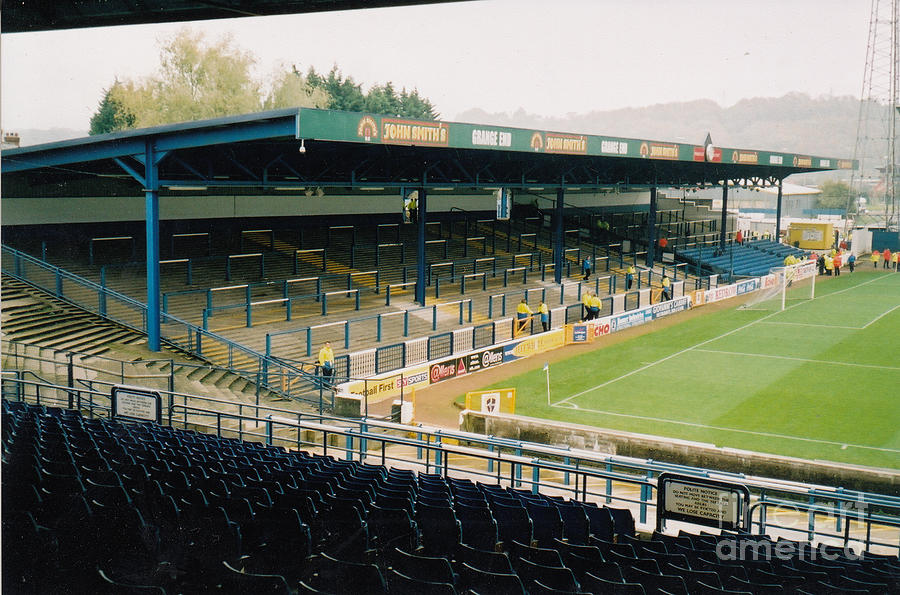
The Grange End on my second, and last visit. Covered standing, with a small block of seats at the far end
..
12 or so minutes into the game what had been a pleasant drive down had turned into a “fools errand”. Three down by then, the voices of the travelling faithful, who, in the absence of standing allocation, were herded into the wing of the Main Stand, started to rise in dissent. The disappointment of a toothless start to the game rose into a crescendo directed at Chairman, Brendan Elwood. It all dated back a couple of weeks when fans favourite, Bill Williams, had seemingly had some kind of spat with Elwood, the result of which was his omission from the starting line-up, and indeed the squad as well. With one voice the chant of “We want Elwood out” echoed round the sparsely occupied arena. There was never much clarity about what had actually happened, but it was certainly a display of disaffection. The next 80 minutes or so assuaged the anger, as goals from Neil Matthews; Chris Beaumont and Paul (A) Williams made it an impressive come-back. I will return to some reflections on Elwood’s impact on County at some point in the future but as Arthur and I wended out way north that Saturday evening there was a fair degree of satisfaction that it was a point rescued from the jaws of defeat. What we didn’t know at the time was the fight back was one of the first signs of a team that could go onto achieve what would be the first promotion in nearly a quarter of a century a few months later.
April 2020
..
VISITS
..
| Day | Date | Competition | Tier / Round | Opponents | Res | F | A | Crowd | Away Day |
| Sat | 22/09/90 (Highlights) | Barclays League Division 4 | Tier 4 | Cardiff City | D | 3 | 3 | 3,374 | 194 |
| Sat | 14/09/02 (Highlights) | Nationwide Football League – Division 2 | Tier 3 | Cardiff City | L | 1 | 2 | 11,546 | 467 |
..
ON MY JOURNEY WITH COUNTY AROUND 180 GROUNDS
..
Previously – GLANFORD PARK Next stop – BESCOT STADIUM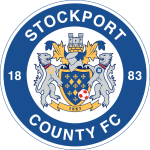

Recent Comments